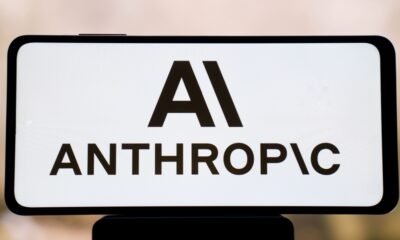By James Panichi ( September 16, 2025, 06:44 GMT | Insight) — Australia intends to regulate artificial intelligence “as much as necessary and as little as possible” in a way that doesn’t hinder the growth of a local AI sector, according to the country’s digital minister. Speaking in Sydney, Digital Economy Minister Andrew Charlton also said that while government policy should support AI development, this needed to be done in a way that protects people from “risks and hazards that are associated with any change of this magnitude.”Australia intends to regulate artificial intelligence “as much as necessary and as little as possible” in a way that doesn’t hinder the growth of a local AI sector, according to the country’s digital minister….
AI Insights
Anthropic CEO sees 3 areas where policymakers can help with AI

Policymakers can make a positive impact on the U.S. artificial intelligence ecosystem by focusing on export controls, basic guardrails and job displacement support, according to Anthropic CEO Dario Amodei.
Speaking at the Anthropic Futures Forum on Monday, Amodei shed light on the approach his company is taking to develop and deploy safe and effective AI solutions, particularly around large language models and agentic AI tools. He offered examples of use cases for emerging AI capabilities, such as in the medical and scientific research arenas, but also acknowledged the risk potential inherent to advanced AI systems.
“I think it’s more the risks where government has a role to play,” he said. “This is the biggest threat and the biggest opportunity for national security that we’ve seen in the last 100 years.”
Amodei further detailed Anthropic’s recent restriction on disseminating its models to Chinese companies or subsidiaries, which amounted to hundreds of millions of dollars in revenue, noting that similar embargos should occur with semiconductor chips to prevent misuse by adversarial actors.
“I think chips are the single ingredient where we kind of most have an advantage. The technology stack for building these is very difficult. We’re being very consistent when we advocate the same thing be done at the chip layer,” Amodei said. “It’s not some attempt to manipulate and order the chip market. We’re doing this at every layer of stack. We think it’s the right thing to do.”
In addition to balanced export controls, Amodei supported government setting rudimentary guardrails on AI, particularly surrounding model training transparency and requirements for companies to conduct basic transparency tests that are publicly available.
He echoed Trump administration officials in prioritizing policy that serves as “a very loose set of requirements, so it doesn’t slow down the innovation and all the benefits.”
But when it comes to mitigating job displacement as a result of AI adoption and creation, Amodei acknowledged that he doesn’t think there is a viable solution to fully cushion AI’s economic impact, but said it is something that needs to be discussed.
“If this is something that’s going to affect 300 million Americans and a bunch of people in other countries as well, people deserve to know that there may be these large job displacement effects,” he said.
Amodei will likely reiterate these suggestions as he and Anthropic leadership, specifically co-founder Jack Clark, head to Capitol Hill to meet with lawmakers as the federal government works to both harness the benefits and tame the risks of AI.
AI Insights
Indigenous peoples and Artificial Intelligence: Youth perspectives on rights and a liveable future

On August 9, 2025, the world marked the International Day of the World’s Indigenous Peoples under the theme: “Indigenous Peoples and Artificial Intelligence: Defending Rights, Sustaining the Future.” It’s a powerful invitation to ask how emerging tools like AI can empower Indigenous Peoples, rather than marginalise them.
Before we answer how, we need to be clear on who we are talking about and what they face in Cameroon and across the Congo Basin.
Who are Indigenous Peoples in Cameroon?
Cameroon is home to several Indigenous Peoples and communities, including groups often called forest peoples (such as the Baka, Bagyeli, Bedzang) as well as the Mbororo pastoralists and communities commonly referred to as Kirdi. There is no single universal definition of “Indigenous Peoples,” but the UN Declaration on the Rights of Indigenous Peoples (2007) places self-determination at the centre of identification.
The realities: living on the margins
- Land grabbing and loss of forests. Forests are the supermarket, pharmacy, culture and identity of Indigenous communities in the Congo Basin. Yet illegal and abusive logging, land acquisitions and agroforestry projects without proper consultation put their well-being at risk.
- Chiefdoms without recognition. The lack of official recognition of Indigenous chiefdoms weakens participation in decision-making and jeopardises their future.
- No specific national law. Cameroon still lacks a specific legal instrument on Indigenous rights. Reliance on international norms alone doesn’t reflect the local context and leaves gaps in protection.
- Limited access to education and health. Many Indigenous children lack birth certificates, which blocks school enrolment and access to basic services.
I believe the future can be different: one where Indigenous autonomy is respected, traditional knowledge is valued, and well-being is guaranteed.
So where does AI fit in, and what can youth do?
AI isn’t a silver bullet; however, in the hands of informed, organised youth it can accelerate participatory advocacy, surface evidence, and protect community rights.
First, AI-assisted mapping, with consent, can document traditional territories, sacred sites, and resource use, turning them into community-owned evidence for authorities and companies.
Moreover, small AI models can preserve language and knowledge: oral histories, songs, medicinal plants, place names under community data sovereignty, with Indigenous Peoples retaining exclusive rights.
Meanwhile, simple chatbots or workflows offer legal triage (from birth-certificate requests to land-grievance tracking and administrative appeals).
Likewise, crowdsourced reports plus AI enable early-warning and accountability on suspicious logging, new roads, or fires, which young monitors can visualise and escalate to community leaders, media, and allies.
Finally, youth pre-bunk/de-bunk teams can counter misinformation with community-approved information. Above all, use of AI must follow Free, Prior and Informed Consent (FPIC), strong privacy safeguards, and real community control of data.
My commitment as a young activist

As an activist, and with a background in law, I want to keep building projects that put Indigenous Peoples at the centre of decisions. AI can help: it enables faster, structured, participatory advocacy and supports a community-owned database of solutions and traditional knowledge, with exclusive rights for Indigenous communities over any derivative products. My legal training helps me work at the intersection of Indigenous rights, AI, and forest/biodiversity protection.
A call to action
The 2025 theme is more than a slogan; it’s a call to act so that technology serves justice, not exclusion. In Cameroon, where Indigenous Peoples are still fighting for legal recognition, AI must be wielded as a tool of solidarity. With support from allies like Greenpeace Africa and the creativity of youth, a future rooted in dignity and sustainability is within reach.
MACHE NGASSING Darcise Dolorès, Climate activist
AI Insights
Our AI regulation will be light-touch, Australian minister tells tech companies | MLex
Prepare for tomorrow’s regulatory change, today
MLex identifies risk to business wherever it emerges, with specialist reporters across the globe providing exclusive news and deep-dive analysis on the proposals, probes, enforcement actions and rulings that matter to your organization and clients, now and in the longer term.
Know what others in the room don’t, with features including:
- Daily newsletters for Antitrust, M&A, Trade, Data Privacy & Security, Technology, AI and more
- Custom alerts on specific filters including geographies, industries, topics and companies to suit your practice needs
- Predictive analysis from expert journalists across North America, the UK and Europe, Latin America and Asia-Pacific
- Curated case files bringing together news, analysis and source documents in a single timeline
Experience MLex today with a 14-day free trial.
AI Insights
Smartphone Maker Nothing Raises $200 Million to Build AI Devices

Nothing Technologies Ltd., a smartphone maker founded just five years ago, has raised $200 million to try and develop the next generation of AI-native devices.
Source link
-

 Business3 weeks ago
Business3 weeks agoThe Guardian view on Trump and the Fed: independence is no substitute for accountability | Editorial
-
Tools & Platforms1 month ago
Building Trust in Military AI Starts with Opening the Black Box – War on the Rocks
-

 Ethics & Policy2 months ago
Ethics & Policy2 months agoSDAIA Supports Saudi Arabia’s Leadership in Shaping Global AI Ethics, Policy, and Research – وكالة الأنباء السعودية
-

 Events & Conferences4 months ago
Events & Conferences4 months agoJourney to 1000 models: Scaling Instagram’s recommendation system
-

 Jobs & Careers3 months ago
Jobs & Careers3 months agoMumbai-based Perplexity Alternative Has 60k+ Users Without Funding
-

 Podcasts & Talks2 months ago
Podcasts & Talks2 months agoHappy 4th of July! 🎆 Made with Veo 3 in Gemini
-

 Education3 months ago
Education3 months agoVEX Robotics launches AI-powered classroom robotics system
-

 Education2 months ago
Education2 months agoMacron says UK and France have duty to tackle illegal migration ‘with humanity, solidarity and firmness’ – UK politics live | Politics
-

 Podcasts & Talks2 months ago
Podcasts & Talks2 months agoOpenAI 🤝 @teamganassi
-

 Funding & Business3 months ago
Funding & Business3 months agoKayak and Expedia race to build AI travel agents that turn social posts into itineraries









